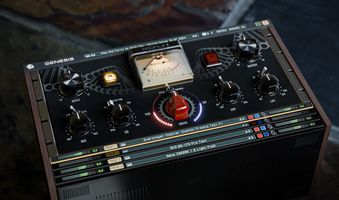AnalogX Blog
Dive into the world of audio production with the AnalogX Blog, your go-to resource for tips, techniques, and insights into mastering the art of sound. Whether you're a seasoned producer or just starting out, explore engaging posts on everything from analog emulation to cutting-edge digital tools. Discover how to get the best from your mixes using our products, learn industry secrets, and stay inspired with creative ideas tailored for modern music creators. Transform your audio journey with us—one post at a time!

Why Tape is Still Important in Modern Recording
Written by Stuart Dawson 09.01.25
Explore the timeless magic of tape in today's digital workflows. This blog dives into the warmth, character, and natural compression of tape recording, and shows how you can recreate its aesthetic using the AnalogX Genesis plugin and tape emulations. Perfect for enhancing vocals, drums, or your mix bus, discover how to blend analog charm with digital precision in your productions.

Why Tape is Still Important in Modern Recording
Introduction
Tape recording has long been revered for its warmth, character, and unique sonic imprint. While digital audio offers pristine clarity and unparalleled convenience, there’s a reason many producers and engineers continue to incorporate tape—or its digital emulations—into modern workflows. In this post, we’ll explore what makes tape special, how it differs from digital recording, and practical ways to achieve the best of both worlds using tools like the AnalogX Genesis plugin and a free MCI tape machine emulation.
Tape vs. Digital: The Aesthetic Differences
Tonal Characteristics
- Tape: Natural warmth and low-mid enhancement that adds richness to recordings. High frequencies often have a slight roll-off, creating a smoother, less harsh top end.
- Digital: Offers a transparent and precise sound, capturing every detail with near-perfect fidelity. However, it can sometimes feel sterile compared to the organic feel of tape.
Harmonic Distortion and Saturation
- Tape: Introduces musically pleasing even-order harmonics, imparting subtle saturation and texture that enhance transients and tonal balance.
- Digital: Clean and free of harmonic distortion unless emulated. Requires plugins or hardware to introduce analog-style warmth.
Compression and Dynamics
- Tape: Naturally compresses audio at higher input levels, smoothing transients and taming peaks for a cohesive sound.
- Digital: Captures a broader dynamic range without compression, which can sometimes make peaks feel overly sharp.
Noise and Artifacts
- Tape: Includes tape hiss and minor imperfections, which add character and a nostalgic 'live' quality.
- Digital: Virtually noise-free, with no inherent artifacts unless added deliberately.
Why Tape is Still Relevant
Despite digital’s advantages, the musicality of tape remains unmatched for many applications:
- Vocals: Tape smooths harsh sibilance and adds warmth, making vocals feel more present.
- Drums: The transient taming and natural compression enhance punch and cohesion.
- Mix Bus: Tape glues mixes together, providing a polished, unified sound.
Modern tools like the AnalogX Genesis plugin allow you to harness these qualities without the need for physical tape machines, making tape’s aesthetic accessible to everyone.
Using Genesis and Tape Emulations to Recreate Tape Magic
The AnalogX Genesis plugin is a transformative tool that combines the tonal qualities of analog gear with modern flexibility. Its ability to load tape machine emulations into one of its four emulation slots makes it ideal for achieving tape-like warmth and character.
Step-by-Step: Adding Tape Characteristics Using Genesis
1. Load a Tape Emulation in Genesis:
- Open Genesis in your DAW and load an MCI tape machine emulation into one of the four slots.
2. Adjust Gain Staging:
- Ensure your input signal (Pre Genesis) hits the emulation at around -18 dBFS, the sweet spot for most analog emulations. Turn on the autogain switch to maintain consistent levels. - Use the Drive knob to control the amount of harmonic saturation. Start with a low to moderate drive setting to add warmth without over-saturating.
3. Tweak the EQ:
- Use Genesis’ One Knob EQ to apply a gentle high-shelf boost before the tape emulation to compensate for the natural high-frequency roll-off. Place the EQ pre-processing for clean tonal shaping or post-processing for harmonically enriched adjustments. This was common practice in the old days of analog recording to ensure playback from the tape machine was bright enough for the mixing process.
4. Blend Wet/Dry Signal:
- Use the Dry/Wet mix control to balance the processed signal with the original. This allows you to retain clarity while adding tape warmth.
5. Experiment with Tape Speed:
- Most MCI emulations include tape speed settings. Higher speeds (e.g., 15 ips) offer a brighter, cleaner sound, while lower speeds (e.g., 7.5 ips) provide thicker lows and a vintage vibe.
Practical Applications
Vocals
- Load the MCI tape emulation in Slot 1 of Genesis.
- Add a subtle high-shelf boost with the One Knob EQ set pre-processing.
- Use the Drive knob to gently saturate the signal, adding richness and smoothing harshness.
Drums
- Load the tape emulation in Slot 2 of Genesis.
- Use the Dry/Wet mix control to blend processed and unprocessed signals, enhancing transients without over-saturating.
- Apply a low-pass filter post-tape to remove any excessive high-end harshness.
Mix Bus
- Stack multiple emulations in Genesis’ slots: load a British 4000 console emulation in Slot 1 and the tape emulation in Slot 2.
- Use the Auto Gain feature to maintain consistent levels.
- Apply gentle compression with another emulation in Slot 3 for added glue.
Blending Analog and Digital
With tools like Genesis and free tape emulations, you can combine the best of both worlds:
- Digital Precision: Use your DAW for detailed editing and automation.
- Analog Character: Add warmth, texture, and harmonic richness with Genesis and tape profiles.
This hybrid approach allows you to craft mixes with the clarity of digital and the musicality of analog.
Conclusion
Tape remains an essential aesthetic in modern recording, and with plugins like AnalogX Genesis, you no longer need physical tape machines to achieve its iconic sound. Whether you’re sculpting vocals, enhancing drums, or gluing your mix, tape emulations provide the warmth, cohesion, and character that digital alone cannot replicate.
Take advantage of Genesis’ flexible emulation slots and advanced features to bring the timeless beauty of tape into your productions today.
---
AnalogX: Transforming Your Audio, One Emulation at a Time